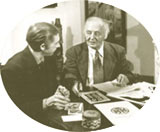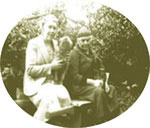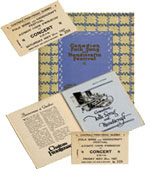|
|
|
Barbeau's StoryAn Advocate of the Arts (1)In 1915, I collected information on the social organization of the Tsimshian, Totem Pole People. They are noted for theirtotem pole carvings, their masks and Chilkat blankets and other features of art of the Northwest Coast. Later in the '20s, I took well known people like Sir Ernest MacMillan, Alexander-Young Jackson and Edwin Holgate with me to make records of the totem poles as they looked, of the Indians as they looked in their potlatches with their costumes. Getting their opinion as to the quality of this art, that is what I wanted to do. The first of the West Coast painters I became acquainted with was Emily Carr, as early as 1916. In 1926, she showed me her paintings and I was impressed with the interesting quality of their totem . So I thought, "Now I am going to urge the National Gallery to give an exhibition of these paintings and at the same time have the National Museum exhibit the masks, the totems, the carvings we have there, in a joint exhibition for Ottawa, for Toronto, for Montréal." Another artist I associated with was Langdon Kihn, when the Macmillan Company came and asked me to write a book around the portraits which Langdon Kihn had made of Indians in the southern Rockies, which was my Indian Days in the Canadian Rockies. Jackson very coyly said: "Why don't you use some of ourselves, Canadians; we could illustrate and we would be pleased to work with you. "So I was taken aback. I had not thought of this before, of asking a Canadian painter to come with me. They came, and their contribution was important and interesting: inspiring totem poles, Indians, the country, the Mountains, and I enjoyed their company. They travelled with me wherever I went among those Indians, and their work formed part of our big exhibition on the Northwest Coast at the National Gallery in 1927-28. At the end of May 1927, we had a festival organized at the Château Frontenac: a week's programs of folksongs and folk dances. There was an exhibition at the same time of wood carving, and we brought wood carvers of the school of Louis Jobin. We had folk singers from the country, we had wood carvers, we had weavers, we had Assomption sash weavers (The obvious success of this festival led organizers to organize the event in a more lavish way the following year, in May 1928. In spite of its success, there was no festival in 1929. Canadian Pacific, principal sponsor of the event, organized the festival for a last time in 1930 without the help of Marius Barbeau, who was too busy with other matters.) |
Bibliography · Links · Credits · Index




